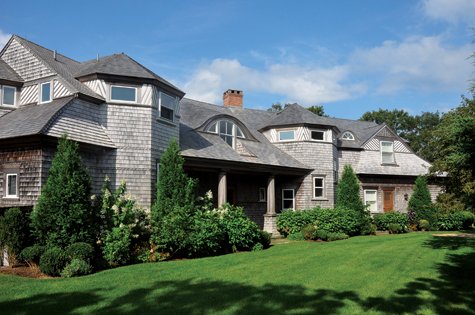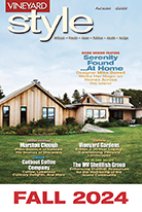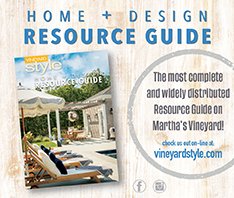HOME PORTRAIT

Architect Joseph W. Dick
Designs An Arts & Crafts-Inspired Home That Grows Better Each Year
By Karla Araujo
Architect Joseph Dick has designed upward of sixty homes on Martha’s Vineyard – and many more off-Island as well – since he started his own practice in the mid-1980s. Unlike other architects whose work has a signature look, Joe’s projects are distinctly different from one another and linked only by his guiding principles: They must be assiduously thought out and all the parts must come together to form an elegant, harmonious solution to a unique situation. “Beautiful design has to solve a problem,” he says firmly.
ThisArts and Crafts-inspired home on an Edgartown's coastal ponds was one of Joe’s earliest projects. He designed it in the late 1980s and construction began in 1990. He has remained involved with the house through three consecutive owners, most recently expanding a second floor terrace with sweeping views of a cove, inlet and the wider pond to the west. The house, as you will see, provides a true reflection of his design principles at work.
From the largest of houses to the smallest of artist studios, Joe and his wife and business partner Michele Maykel have worked together on projects in disparate locations. From the Vineyard, the Cape and Nantucket to Miami’s Fisher Island and midtown Manhattan, their firm, Joseph W. Dick Architecture, has given the couple the opportunity to collaborate on all types of residential work: new homes, historic restorations and renovations of existing homes, salvaging and transforming existing
but inadequate buildings.
Joe is a graduate of Columbia College and holds a master’s degree in architecture from Columbia’s Graduate School of Architecture and Planning. Michele was trained as an artist and is a graduate of the Massachusetts College of Art. He oversees all aspects of architectural services, from concept through completion, while Michele manages interior art for clients, from carpet design to color choices and finishes. Much of their work is in coastal or waterfront sites, in historic districts or adjacent to wetlands, so they’re accustomed to dealing with the nuances of challenging locations.
One such setting is the 15-acre pond property on which Joe designed this sprawling, yet surprisingly unobtrusive, 4,500-square-foot home and detached three-car garage / guesthouse.
“I spent a great deal of time studying the relationship between the potential home site and the pond,” he explains. “I wanted it to settle into the landscape but still maximize its views.” He carefully sited and designed the main house to wrap around the cove, bending the structure to ensure that the view from each room would be compelling yet different. In keeping with his naturalist tendencies, he also retained as many of the lot’s oak trees as possible, prizing them for their sculptural appearance.
Working within the town’s 26-foot height limit, Joe maximized the living space and openness of the interior while retaining the traditional shingle style architectural feel. The original owners, he says, were a British family who conveyed their desire for a relaxed, rambling residence in sync with nature. “The design sprang from my predilection for shingle style,” he says. “With a more modern feeling, a fluidity. A melding of contemporary and classic.” To mask the mass of the house, Joe brought down its scale with the roofline and nestled it into the woods. Using bay shapes as a dominant theme, he increased usable interior space without adding bulk. The enveloping roof sweeps down to the first floor eave level and creates a constant line that wraps around the house, lowering it to a human scale. “The house isn’t brooding,” he says. “I interrupted the line with turrets and bay forms that poke through, a weaving of old and new.”
Designed well before the green building revolution, the pond house nevertheless reflects Joe’s early adoption of an energy efficient and environ-mentally sensitive approach. He deliberately sited the home so that it would stay as cool as possible in the summer months, sheltered it from the brunt of storms, created enveloping roofs with insulation, situated the rooms to take advantage of flow-through ventilation and utilized natural materials wherever possible. He also designed it with unpainted and unstained natural shingle and unpainted trim. “The least expensive ways of being efficient are often the best,” he says. “Bring in technology after you’ve exhausted all natural methods.”
A tribute to the architect’s imaginative yet classic vision, the house has remained relatively unchanged over its 23-year history. The kitchen, designed to the original owners’ tastes as a more traditionally intimate space with separate butler’s pantry – much like that of an old English country home – was opened up and updated. The bathroom fixtures, initially kept to a budget, have been upgraded as well. And recently, the present owners, a professional couple whose primary home is in New Jersey, asked Joe to revisit the house to expand its second floor rear terrace. They utilize the home primarily during the summer and wanted the open deck to be enjoyed by more family and friends than its small space would allow.
Long-time Island vacationers, the couple purchased the home in 2010, citing its calm waterfront setting as a major draw. “The cove is very special, tranquil and serene,” they explain, “but a constant hub of activity for wildlife. There is always something to see – hummingbirds, finches, cardinals, fishing osprey, herons, swans, otters munching on oysters, rabbits, butterflies.” But Joe’s meticulous site planning and design didn’t go unnoticed. They add: “The back of the house has interesting angles that contour the water with each room, offering a unique perspective and different views of the garden and cove. The differently angled windows ensure that the house is brightened by sunlight throughout the day.”
When they bought the property, the new owners retained the services of Soho-based Interior Designer Jason Bell of J.D. Bell Inc., who had worked with them on their primary home. “When we started the project they really didn’t give me direction,” Jason says. “My intuition was to connect the interior color and textures with all the natural beauty that surrounds the house, to bring the garden and water coloring in.”
Beginning with the chintz fabric in the living room as the core, Jason built the rest of the space around it. There was no furniture and, with his guidance, the main bathrooms, kitchen and dining room were gutted and refurbished. “We painted or papered every surface of the house to coordinate with the chosen scheme,” he says. “All furniture, lighting, rugs, carpets, window treatments, plumbing fixtures, tiles and cabinetry were selected or designed.” Striving for a “calming, sophisticated and timeless look,” Jason characterizes the finished product as “a modern take on English country.”
The interior of the house offers, as Joe intended, a series of surprises to the first-time visitor and, for the already initiated, ongoing opportunities to enjoy its unique architectural features. The two-story entry foyer, with its herringbone-patterned, vintage reclaimed bricks, opens to a large, sun-drenched, southern-facing living room with dramatic pond and garden views. Competing with the vista is the extraordinary sight of the open ceiling and bridge that crosses the space above, drawing the eye upward and piquing interest.
The main level consists of the living area, formal dining room, generous gourmet kitchen, a guest or au pair suite, laundry room, and one of two master bedroom suites. The living room also features a more intimate TV nook with lower ceilings, a cozy spot to curl up in – part of the family activity but slightly detached. Throughout the first floor, horizontal crown moldings wrap the rooms, playing against the verticality of the ceiling height.
The interior palette is soft and marine-inspired, its primary seafoam color shifting with the light from pale green to aqua. Traditional American, British and Asian elements coexist easily, with more formal reproduction furniture melding with cottage style, while striped, floral and plaid fabrics keep the mood light and airy.
An unusual touch is the placement of the graceful curved stairway in the dining room. “I chose not to design a central monumental stair,” Joe says. “That would feel static. I wanted the flow to draw you into the dining room and up the stair. It’s more interesting to have a stair reveal itself obliquely. That way it’s a sophisticated draw, not a hammer.”
The second floor consists of two separate wings: another master bedroom suite above that on the first floor; a dramatic central bridge and balconies that crisscross atop the living room, linking the adult space with the children’s bunkroom and hall bath. The bridge leads to the outdoor terrace, at treetop level with breathtaking views of the grounds and water.
Octagonal rooflines and moldings that weave the vertical and horizontal space together repeat throughout the house. And, as often as possible, Joe designed the rooms with three exposures out to the bay, optimizing views, light and air. He also deliberately reduced visual clutter by keeping the views as the central focus.
The original construction and subsequent renovations were undertaken by two Island builders, both at Joe’s behest: Colin Whyte of Martha’s Vineyard Construction and John Early of John G. Early Contractor & Builder. “I felt privileged to work with two such fine builders on a single project,” Joe says.
Today, nearly 25 years after he first conceived of the coastal pond design, Joe’s favorite aspect of the house is unchanged: “It’s the siting,” he says, pointing to the bend of the house as it conforms to the shape of the land. “Each room has a panoramic view but different character. As you move through the house, you enjoy a varied experience. And then, when you reach the balcony, everything is revealed. It’s the surprise at the end of the journey – the cove, the pond and the sea beyond.”
ThisArts and Crafts-inspired home on an Edgartown's coastal ponds was one of Joe’s earliest projects. He designed it in the late 1980s and construction began in 1990. He has remained involved with the house through three consecutive owners, most recently expanding a second floor terrace with sweeping views of a cove, inlet and the wider pond to the west. The house, as you will see, provides a true reflection of his design principles at work.
From the largest of houses to the smallest of artist studios, Joe and his wife and business partner Michele Maykel have worked together on projects in disparate locations. From the Vineyard, the Cape and Nantucket to Miami’s Fisher Island and midtown Manhattan, their firm, Joseph W. Dick Architecture, has given the couple the opportunity to collaborate on all types of residential work: new homes, historic restorations and renovations of existing homes, salvaging and transforming existing
but inadequate buildings.
Joe is a graduate of Columbia College and holds a master’s degree in architecture from Columbia’s Graduate School of Architecture and Planning. Michele was trained as an artist and is a graduate of the Massachusetts College of Art. He oversees all aspects of architectural services, from concept through completion, while Michele manages interior art for clients, from carpet design to color choices and finishes. Much of their work is in coastal or waterfront sites, in historic districts or adjacent to wetlands, so they’re accustomed to dealing with the nuances of challenging locations.
One such setting is the 15-acre pond property on which Joe designed this sprawling, yet surprisingly unobtrusive, 4,500-square-foot home and detached three-car garage / guesthouse.
“I spent a great deal of time studying the relationship between the potential home site and the pond,” he explains. “I wanted it to settle into the landscape but still maximize its views.” He carefully sited and designed the main house to wrap around the cove, bending the structure to ensure that the view from each room would be compelling yet different. In keeping with his naturalist tendencies, he also retained as many of the lot’s oak trees as possible, prizing them for their sculptural appearance.
Working within the town’s 26-foot height limit, Joe maximized the living space and openness of the interior while retaining the traditional shingle style architectural feel. The original owners, he says, were a British family who conveyed their desire for a relaxed, rambling residence in sync with nature. “The design sprang from my predilection for shingle style,” he says. “With a more modern feeling, a fluidity. A melding of contemporary and classic.” To mask the mass of the house, Joe brought down its scale with the roofline and nestled it into the woods. Using bay shapes as a dominant theme, he increased usable interior space without adding bulk. The enveloping roof sweeps down to the first floor eave level and creates a constant line that wraps around the house, lowering it to a human scale. “The house isn’t brooding,” he says. “I interrupted the line with turrets and bay forms that poke through, a weaving of old and new.”
Designed well before the green building revolution, the pond house nevertheless reflects Joe’s early adoption of an energy efficient and environ-mentally sensitive approach. He deliberately sited the home so that it would stay as cool as possible in the summer months, sheltered it from the brunt of storms, created enveloping roofs with insulation, situated the rooms to take advantage of flow-through ventilation and utilized natural materials wherever possible. He also designed it with unpainted and unstained natural shingle and unpainted trim. “The least expensive ways of being efficient are often the best,” he says. “Bring in technology after you’ve exhausted all natural methods.”
A tribute to the architect’s imaginative yet classic vision, the house has remained relatively unchanged over its 23-year history. The kitchen, designed to the original owners’ tastes as a more traditionally intimate space with separate butler’s pantry – much like that of an old English country home – was opened up and updated. The bathroom fixtures, initially kept to a budget, have been upgraded as well. And recently, the present owners, a professional couple whose primary home is in New Jersey, asked Joe to revisit the house to expand its second floor rear terrace. They utilize the home primarily during the summer and wanted the open deck to be enjoyed by more family and friends than its small space would allow.
Long-time Island vacationers, the couple purchased the home in 2010, citing its calm waterfront setting as a major draw. “The cove is very special, tranquil and serene,” they explain, “but a constant hub of activity for wildlife. There is always something to see – hummingbirds, finches, cardinals, fishing osprey, herons, swans, otters munching on oysters, rabbits, butterflies.” But Joe’s meticulous site planning and design didn’t go unnoticed. They add: “The back of the house has interesting angles that contour the water with each room, offering a unique perspective and different views of the garden and cove. The differently angled windows ensure that the house is brightened by sunlight throughout the day.”
When they bought the property, the new owners retained the services of Soho-based Interior Designer Jason Bell of J.D. Bell Inc., who had worked with them on their primary home. “When we started the project they really didn’t give me direction,” Jason says. “My intuition was to connect the interior color and textures with all the natural beauty that surrounds the house, to bring the garden and water coloring in.”
Beginning with the chintz fabric in the living room as the core, Jason built the rest of the space around it. There was no furniture and, with his guidance, the main bathrooms, kitchen and dining room were gutted and refurbished. “We painted or papered every surface of the house to coordinate with the chosen scheme,” he says. “All furniture, lighting, rugs, carpets, window treatments, plumbing fixtures, tiles and cabinetry were selected or designed.” Striving for a “calming, sophisticated and timeless look,” Jason characterizes the finished product as “a modern take on English country.”
The interior of the house offers, as Joe intended, a series of surprises to the first-time visitor and, for the already initiated, ongoing opportunities to enjoy its unique architectural features. The two-story entry foyer, with its herringbone-patterned, vintage reclaimed bricks, opens to a large, sun-drenched, southern-facing living room with dramatic pond and garden views. Competing with the vista is the extraordinary sight of the open ceiling and bridge that crosses the space above, drawing the eye upward and piquing interest.
The main level consists of the living area, formal dining room, generous gourmet kitchen, a guest or au pair suite, laundry room, and one of two master bedroom suites. The living room also features a more intimate TV nook with lower ceilings, a cozy spot to curl up in – part of the family activity but slightly detached. Throughout the first floor, horizontal crown moldings wrap the rooms, playing against the verticality of the ceiling height.
The interior palette is soft and marine-inspired, its primary seafoam color shifting with the light from pale green to aqua. Traditional American, British and Asian elements coexist easily, with more formal reproduction furniture melding with cottage style, while striped, floral and plaid fabrics keep the mood light and airy.
An unusual touch is the placement of the graceful curved stairway in the dining room. “I chose not to design a central monumental stair,” Joe says. “That would feel static. I wanted the flow to draw you into the dining room and up the stair. It’s more interesting to have a stair reveal itself obliquely. That way it’s a sophisticated draw, not a hammer.”
The second floor consists of two separate wings: another master bedroom suite above that on the first floor; a dramatic central bridge and balconies that crisscross atop the living room, linking the adult space with the children’s bunkroom and hall bath. The bridge leads to the outdoor terrace, at treetop level with breathtaking views of the grounds and water.
Octagonal rooflines and moldings that weave the vertical and horizontal space together repeat throughout the house. And, as often as possible, Joe designed the rooms with three exposures out to the bay, optimizing views, light and air. He also deliberately reduced visual clutter by keeping the views as the central focus.
The original construction and subsequent renovations were undertaken by two Island builders, both at Joe’s behest: Colin Whyte of Martha’s Vineyard Construction and John Early of John G. Early Contractor & Builder. “I felt privileged to work with two such fine builders on a single project,” Joe says.
Today, nearly 25 years after he first conceived of the coastal pond design, Joe’s favorite aspect of the house is unchanged: “It’s the siting,” he says, pointing to the bend of the house as it conforms to the shape of the land. “Each room has a panoramic view but different character. As you move through the house, you enjoy a varied experience. And then, when you reach the balcony, everything is revealed. It’s the surprise at the end of the journey – the cove, the pond and the sea beyond.”








